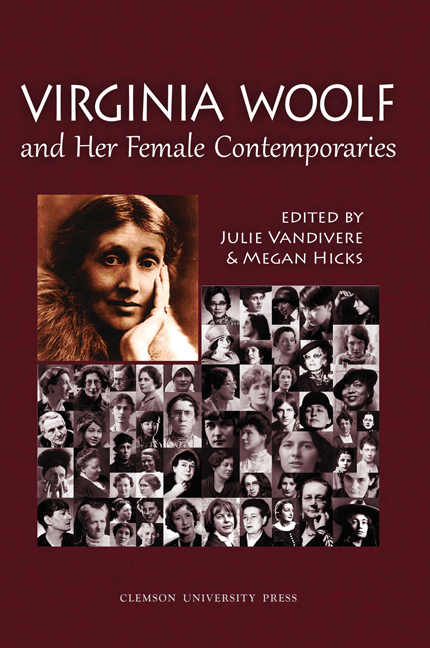Book contents
- Frontmatter
- Table of Contents
- Introduction
- Acknowledgments
- Abbreviations
- Who Are Virginia Woolf's Female Contemporaries?
- Virginia Woolf's Cultural Contexts
- Virginia Woolf's Contemporaries Abroad
- Reconfiguring the Mermaid: HD, Virginia Woolf, and the Radical Ethics of Writing as Marine Practice
- A Carnival of the Grotesque: Feminine Imperial Flânerie in Virginia Woolf 's “Street Haunting” and Una Marson's “Little Brown Girl”
- Mad Women: Dance, Female Sexuality, and Surveillance in the Work of Virginia Woolf and Emily Holmes Coleman
- Shop My Closet: Virginia Woolf, Marianne Moore, and Fashion Contemporaries
- Virginia Woolf and Victoria Ocampo: A Brazilian Perspective
- Making Waves in Lonely Parallel: Evelyn Scott and Virginia Woolf
- Critical Characters in Search of an Author: Cornelia Sorabji and Virginia Woolf
- “In my mind I saw my mother”: Virginia Woolf, Zitkala-Ša, and Autobiography
- Virginia Woolf's Contemporaries at Home
- Tribute to Jane Marcus
- Notes on Contributors
- Conference Program 223
Making Waves in Lonely Parallel: Evelyn Scott and Virginia Woolf
from Virginia Woolf's Contemporaries Abroad
- Frontmatter
- Table of Contents
- Introduction
- Acknowledgments
- Abbreviations
- Who Are Virginia Woolf's Female Contemporaries?
- Virginia Woolf's Cultural Contexts
- Virginia Woolf's Contemporaries Abroad
- Reconfiguring the Mermaid: HD, Virginia Woolf, and the Radical Ethics of Writing as Marine Practice
- A Carnival of the Grotesque: Feminine Imperial Flânerie in Virginia Woolf 's “Street Haunting” and Una Marson's “Little Brown Girl”
- Mad Women: Dance, Female Sexuality, and Surveillance in the Work of Virginia Woolf and Emily Holmes Coleman
- Shop My Closet: Virginia Woolf, Marianne Moore, and Fashion Contemporaries
- Virginia Woolf and Victoria Ocampo: A Brazilian Perspective
- Making Waves in Lonely Parallel: Evelyn Scott and Virginia Woolf
- Critical Characters in Search of an Author: Cornelia Sorabji and Virginia Woolf
- “In my mind I saw my mother”: Virginia Woolf, Zitkala-Ša, and Autobiography
- Virginia Woolf's Contemporaries at Home
- Tribute to Jane Marcus
- Notes on Contributors
- Conference Program 223
Summary
On June 23, 1929, Woolf 's ideas for a novel with the working title The Moths began to crystallize in her mind at last. She writes in her diary:
I think it will begin like this: dawn; the shells on a beach;… then all the children at a long table—lessons. The beginning. Well, all sorts of characters are to be there. Then the person who is at the table can call out any one of them at any moment; & build up by that person the mood, tell a story. (D3: 236)
She continues, “Could one not get the waves to be heard all through?” (D3: 236). Woolf had begun to sketch the beginning of The Waves (1931), although the work would not be called that until October. Little did Woolf realize that Evelyn Scott, another author of great power, had a similar title in mind, and would, on July 1, 1929, only eight days after Woolf 's above ruminations, publish her own modernist masterpiece called The Wave. A massive historical novel of the American Civil War tracing the war's effects through over one hundred characters, The Wave was an instant bestseller in the United States, with sales totaling almost 10,000 by July 10 (White 124), and retained its American popularity for two decades (123). However, as biographer D. A. Callard notes, “Evelyn's novels were… disregarded in England, where sales of The Wave throughout the British empire totaled 380” (120). While Scott's The Wave and Woolf 's The Waves have in common many ideas of conception, and Scott and Woolf shared common elements of their modernist agendas, the authors remained throughout their lives writing in lonely parallel, never meeting or corresponding.
Scott, née Elsie Dunn, was born in Clarksville, Tennessee, in January 1893 (eleven years after Woolf), to a mother well aware of their family's status as “southern gentry” (Maun xxix) and an Ohio-born father (White 8). When Elsie was fourteen, her family moved to New Orleans, where she worked for the Women's Suffrage Party (Maun xxix). Though trained to be a “Southern belle,” Scott resisted her upbringing and “reject[ed] the feminine role prescribed by her society” (Welker vii).
- Type
- Chapter
- Information
- Virginia Woolf and Her Female Contemporaries , pp. 129 - 135Publisher: Liverpool University PressPrint publication year: 2016



